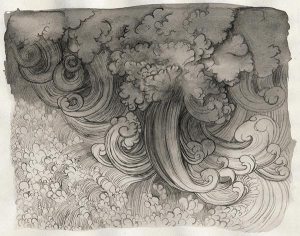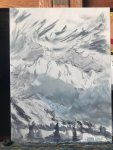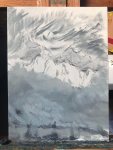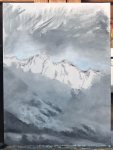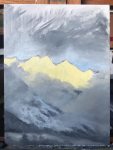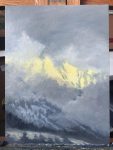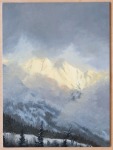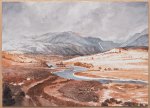
Finally a new post. I’ve been active on Instagram but haven’t felt like I had something substantial enough to put here. This new painting was an experiment using oil paint on a watercolor canvas because I liked its fine weave. The photo reference is from Nancy Winn on Paint my Photo.
I think the package said it was acrylic primed for all media, but to be sure that it was sealed well enough for oil paint I applied an extra coat of gesso. Mixed in with that gesso was a little grey acrylic paint that was leftover from an attempt at a different painting. Immediately after I roughly sketched the scene with diluted black acrylic and a small synthetic dagger brush.
Before beginning with oil paint I let acrylic gesso dry for at least four hours, or until it’s no longer cool to the touch, to be sure that it’s finished whatever mysterious chemical processes are happening as it dries. Since it was late, this was left overnight before starting the next day.
I tried roughly blocking in different areas slowly and at the same time so I’d be able to see how their color was affecting each other. Adjustments needed to be made, such as the lower clouds needing more warmth in their subtle highlights and the sky just not actually having the faint blue that I originally put there. I guess it was a diffuse warm light from a cloud behind the mountains rather than seeing all the way through to the sky. That’s the sort of thing you may not notice at first and at a glance until you’re actually painting a scene and purposefully examining each component of it, so I had just assumed the gap in the clouds was showing all the way through.
This watercolor canvas turned out to be really nice to paint on. It has enough texture that it’s not a slick surface the way some gesso boards can be, but it’s fine enough to allow for much more control of details and for the paint to glide across it more smoothly than it would on a heavier weave canvas. I wouldn’t say the quality control is especially high though, since there’s a lot of little knots and dents in the canvas, but it was good to work on.
If you haven’t check out my Instagram, here, there’s a lot of sketches and paintings there that aren’t posted on this blog.
